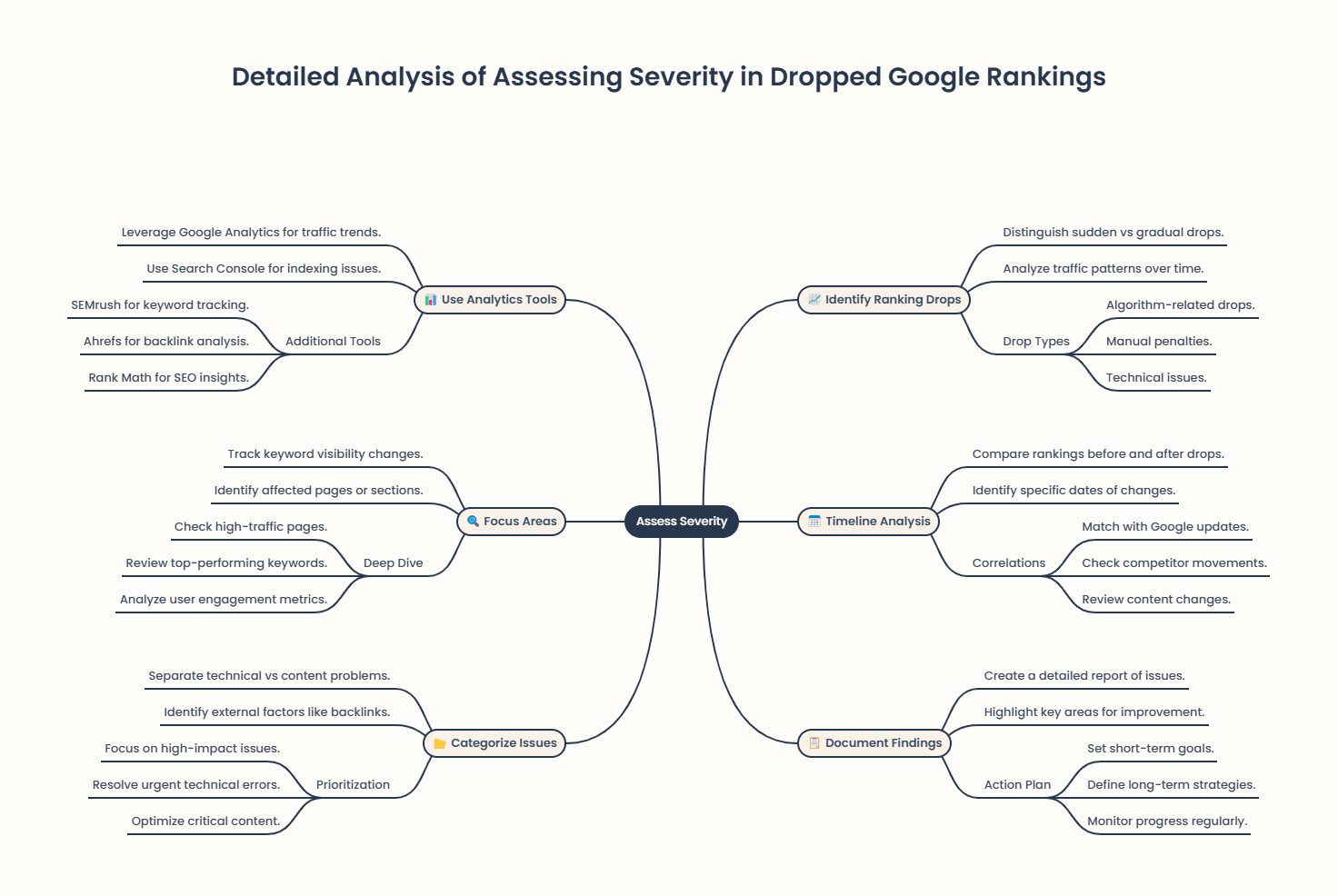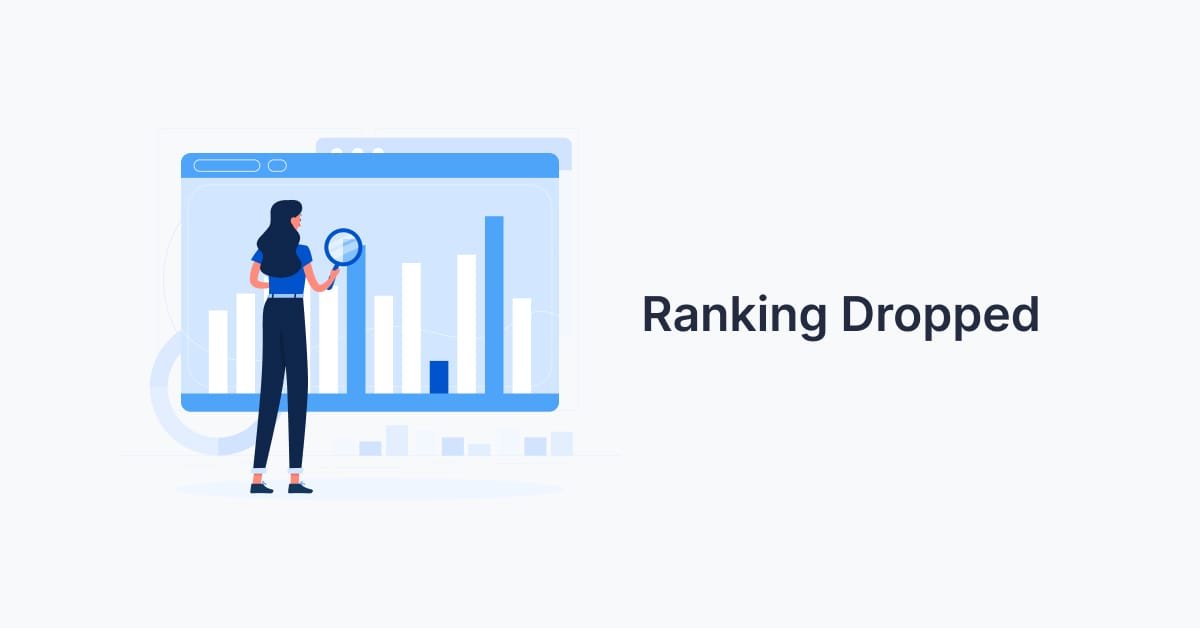Has your website suddenly dropped in Google’s search results? You’re not alone. Studies show up to 90% of sites face ranking changes due to updates or competition. As an SEO expert, I’ve helped many websites through this.
Google’s search algorithm changes a lot, with over 5,000 updates in 2021. These changes can cause big ranking shifts. Many website owners are left wondering what happened and how to fix it. But fear not! I’ve created a detailed guide to help you find and fix the problem.
Whether your ranking drop is small or big, this guide will help. We’ll look at common reasons for ranking changes, do technical audits, and check recent website changes. This will help you understand and fix the issue.
Are you ready to get your rankings back? Let’s start the recovery process together!
Key Takeaways
- Up to 90% of websites experience ranking fluctuations due to various factors
- Google made over 5,000 algorithm changes in 2021
- 60% of ranking drops are attributed to algorithm updates
- Technical issues affect 40% of websites, impacting SEO performance
- Recovery from significant ranking drops typically takes 3 to 6 months
Understanding Ranking Fluctuations and Their Impact
Ranking changes are common in SEO. Websites often see their search positions shift. These changes can be small or big, like a site dropping a page in rankings. It’s important to know these changes are normal and not always a problem.
Google’s search algorithm keeps changing. It updates to show the best results. These updates can change how websites rank, sometimes overnight. Let’s look at why these changes happen.
Common Causes of Ranking Changes
Several things cause ranking changes:
- Algorithm updates: Google often changes its search algorithm, which can change rankings.
- Content changes: Updates to your site’s content can change its value in Google’s eyes.
- Competitor activity: When competitors improve, you might need to update your site to keep up.
- Backlink profile: Losing good backlinks can hurt your rankings.
- Technical issues: Server errors or CDN caching problems can stop Google from crawling and indexing your site.
Knowing these reasons helps keep your site visible. Watch your keywords, do technical checks, and stay up-to-date with algorithm changes. This way, you can handle the changing SEO world well.
Initial Assessment and Data Collection

When I notice a drop in website traffic, I start by gathering data from different sources. I check my rank tracking app, web analytics, and Google Search Console. This helps me understand the full impact of the ranking drop.
SEO is complex, with over 200 ranking factors. I use various tools to get a detailed view. Google made over 5,000 algorithm changes in 2021, so keeping up with these changes is vital.
Ranking drops can happen suddenly and severely. I’ve seen pages drop dozens of positions or even fall out of the top 100. So, I dive deep into the data, looking at:
- Specific pages affected
- Keywords that lost rankings
- Changes in organic traffic patterns
- Shifts in search intent for key queries
By analyzing this data, I can find trends and identify the main cause of the ranking drop. This detective work is key to creating a targeted plan to fight website traffic decline and boost SEO efforts.
Google Rankings Dropped: Immediate Action Steps
When your Google rankings drop, you must act quickly. I’ve been in this situation and it’s very stressful. Here are the steps to take right away to get back on track.

Documentation of Changes
First, document all recent changes to your website. This includes updates to content, design, and technical changes. Make a spreadsheet with each change, the date, and who made it. This will help you find out why your rankings dropped.
Timeline Analysis
Then, look at the timeline of events before the ranking change. Check if your changes match the drop in rankings. Did you update content or switch hosting providers? These could be the reasons for the issue.
Traffic Pattern Review
Examine your traffic patterns closely. Has organic traffic suddenly dropped? This might mean a Google penalty. Also, check your click-through rates. The top page usually gets about 39.8% of clicks. A big drop is a warning sign.
Google rankings can fall for many reasons. These include penalties, lost backlinks, or poor user experience. By taking these steps, you’ll gather the information needed to fix the problem and start your recovery plan.
Technical SEO Audit Checklist
Let’s get into the details of technical SEO issues. A detailed audit can find hidden problems that affect your search engine optimization. I’ll show you the main areas to check.
First, look at your HTTP status codes. All key pages should show a 200 OK status. 404 errors or wrong redirects can harm your rankings. Also, check your canonical URLs to avoid duplicate content issues.
Then, review your meta robots tags and robots.txt file. These control how search engines crawl and index your site. Mistakes here can block important pages from search results.
For international sites, make sure your hreflang tags are correct. These help Google show the right language version to users in different countries. Wrong implementation can cause ranking drops in certain regions.
Lastly, test your Core Web Vitals. Google uses these metrics to judge page experience. Poor scores can hurt your rankings. Work on improving loading speed, interactivity, and visual stability.
Remember, missing one element of this technical SEO checklist can weaken your entire optimization strategy.
By tackling these technical SEO issues, you’ll build a strong base for better search visibility and rankings.
Analyzing Recent Website Changes
I’ve seen many cases where website traffic decline stems from recent modifications. Let’s dig into the key areas that might affect your page rank factors.
Content Modifications Review
Take a close look at your content updates. Did you remove high-performing pages? Or maybe you changed key phrases that were driving traffic? These tweaks can impact your rankings significantly.
Structure and Navigation Changes
Altering your site’s structure can confuse search engines and users alike. Check if you’ve moved important pages, changed menu layouts, or removed internal links. These changes often lead to a dip in traffic.
URL Architecture Updates
URL changes are tricky. If you’ve updated your URL structure without proper redirects, you’re likely to see a drop in rankings. Make sure all old URLs point to their new counterparts.
Remember, large-scale changes often cause ranking drops. If you’ve migrated pages, launched a redesign, or reworked lots of content, expect fluctuations. It’s important to implement changes gradually and monitor their impact on your site’s performance.
- Review content modifications
- Assess structure and navigation updates
- Check URL architecture changes
- Implement changes gradually
- Monitor impact on rankings
By carefully analyzing these areas, you can pinpoint the cause of your website traffic decline and take steps to recover your rankings.
Google Algorithm Update Impact Assessment
Google’s search engine optimization world is always changing. In 2022, Google updated its search 4,725 times. That’s about 13 times a day! These updates can really change how your website ranks.
To see if an update hit your site, check out SEO news sites. Barry Schwartz’s “Was There A Google Update” is a top pick. Tools like Advanced Web Ranking and RankRanger also help track changes.
Big updates have big effects on search results. The March 2024 update cut down on bad content by 40%. The helpful content update makes sure content is valuable. The page experience update looks at how fast your site loads and if it works well on phones.
To figure out how these updates affect your site:
- Watch how your keyword rankings and organic traffic change
- Keep an eye on how users behave, like bounce rates and time on page
- Use tools like Moz and Semrush to see which keywords fell in rank
- Do a technical SEO audit with Google’s Core Web Vital Report
- Check your content against Google’s E-E-A-T principles
Remember, getting back from an update takes time. Stay up-to-date, adjust your plans, and make sure your content is top-notch. This way, you can handle the constant changes in search engine optimization.
Core Web Vitals and User Experience Review
Google now puts a big emphasis on how users feel about your site. This means Core Web Vitals are super important for your ranking. Let’s explore how these metrics impact your site’s performance and what steps you can take to enhance them.
Loading Performance Analysis
Your site’s speed is key. Slow sites can lose visitors and hurt your ranking. Check your page load time in Google Analytics 4 under Behavior > Site Speed > Overview. Tools like CrUX.run can give you a deeper look.
Mobile Responsiveness Check
Mobile searches are now the norm. Your site must look good on all devices. Test your pages on various screen sizes to ensure they’re user-friendly. This is a big part of making your site better for users.
Interactive Elements Evaluation
Buttons, forms, and other interactive parts should work fast. Slow or unresponsive elements can annoy users and hurt your site’s usability. Fixing these technical issues can greatly improve your site’s performance.
Optimizing Core Web Vitals isn’t just for Google. It’s about making your site better for your users. By focusing on these areas, you’ll see better rankings and happier visitors.
Content Quality and Relevance Analysis
Let’s explore content quality analysis, a key part of search engine optimization. Google’s algorithms are getting smarter, focusing on high-quality, relevant content. By 2026, traditional search traffic might drop by 25% due to AI. This makes it vital to focus on content excellence.
First, review your current content. Look for pages with big traffic drops. A 10% yearly decrease in blog posts or an 80% drop in homepage traffic could mean problems. These changes can hurt your sales and visibility.
- Refresh outdated information
- Add new insights and data
- Ensure complete topic coverage
- Improve readability and structure
- Align content with user intent
Google’s recent updates aim at content made for people, not search engines. Focus on adding value to your audience. Use Google Search Console to track your search rankings and find areas to improve.
By doing a deep content quality analysis and making needed changes, you’ll be ready to bounce back from ranking drops. This will help keep your search engine optimization strong.
Backlink Profile Examination
Checking your backlink profile is key to keeping good Google rankings. I’ve seen many sites lose rankings because of bad links. Let’s explore how to keep your site safe and improve your rankings with smart link management.
Toxic Link Identification
Finding harmful links is important. Use tools like Ahrefs or Moz to check your backlinks. Look for links from low-quality sites, spammy directories, or unrelated content. These can harm your rankings and should be removed or disavowed.
Lost Backlink Assessment
Don’t ignore lost backlinks. They’re valuable for SEO. Check which links you’ve lost and why. Try to get them back if they were removed by mistake.
Link Quality Metrics
Quality is more important than quantity in backlinks. Here are key metrics to focus on:
- Domain authority of linking sites
- Relevance to your niche
- Traffic from referring domains
- Anchor text diversity
Remember, high-quality backlinks are vital for page rank. A strong, clean link profile can boost your rankings and protect against algorithm updates.
Regular backlink profile audits are vital. They help keep your link structure healthy and find areas for improvement. By focusing on quality, you’ll build a strong backlink profile that Google appreciates.
Competitor Analysis and Market Changes
When your Google rankings drop, it’s not always your fault. Sometimes, it’s what your competitors are doing. Let’s explore how to bounce back through competitor analysis and market shifts.
Start by using an SEO tool to see if competitors gained rankings where you lost them. This could mean Google’s search intent or content focus has changed. Tools like SEMrush can show you where your SEO strategy is lacking and where you can improve.
Check out your competitors’ content. Are they covering topics you’ve missed? Is their content more in-depth or up-to-date? Google favors fresh, high-quality content. If your rivals are doing better here, it’s time to improve your content.
Don’t overlook backlinks. They’re a key ranking factor for Google. If you’ve lost backlinks while your competitors gained some, that could explain your drop. Use tools like Ahrefs to track link changes over time.
Lastly, watch broader market trends. Changes in user intent can affect what content ranks best. If informational content starts beating transactional pages, you might need to adjust your strategy.
SEO is a continuous effort. Regularly analyzing competitors and monitoring the market will help you stay ahead and recover from ranking drops faster.
SERP Feature Changes and Visibility
When Google rankings dropped, it’s important to look at SERP feature changes. Search engine optimization has changed. Now, features like featured snippets and rich results take up top spots on search pages.
These features can move organic results down. This affects visibility, even if your ranking hasn’t changed. It’s vital to understand and adapt to these changes to keep a strong search presence.
Featured Snippet Opportunities
Featured snippets show up at the top of search results, giving quick answers to questions. They’re a great chance to boost visibility. Make your content clear and answer common questions in your field.
Rich Results Analysis
Rich results add extra details like ratings, prices, or images to your listing. They grab attention and can increase clicks. Using proper schema markup is key to showing up in rich results.
Optimizing for these SERP features can help regain visibility, even if your Google rankings dropped. Remember, search engine optimization is a continuous effort. It needs constant adaptation to the changing search results landscape.
Search Intent Alignment Check
Understanding search intent is key to keeping your site ranked well and avoiding a drop in website traffic. Google’s updates can change how they see user queries, impacting your site’s ranking. In 2023, Google made nine updates, each taking a week or two to roll out.
To match your content with search intent, first look at your target keywords. Google’s Quality Rater Guidelines highlight the role of intent in ranking. Most search terms fall into four types: informational, navigational, commercial, and transactional. A page that meets search intent can rank higher, even without new backlinks or SEO tricks.
For instance, “backlink checker” shows tool results, showing transactional intent. But “best backlink checker” lists top tools, showing informational intent. By focusing on the right intent, you can increase organic traffic and better your site’s metrics.
Keep your content fresh to match changing search intents. This method can lead to more traffic gains than making new content. Watch “People also ask” questions and give clear steps for “How to” queries. This can improve user satisfaction and possibly get you into Featured Snippets.
Mobile SEO Performance Review
In today’s world, how your site performs on smartphones is key. It can make or break your rankings. Let’s take a close look at your mobile SEO. We’ll find any technical issues and ways to improve the user experience.
Mobile-First Index Compliance
Google now ranks sites based on their mobile version. To stay competitive:
- Make sure your site uses responsive design
- Check that content is the same on mobile and desktop
- Ensure all important links work on mobile
Speed Optimization for Mobile
Mobile users want fast load times. Use PageSpeed Insights to find slow spots:
- Compress images and use new formats
- Reduce render-blocking resources
- Enable browser caching
Fixing these technical issues will greatly improve user experience. A fast, responsive mobile site pleases visitors and boosts your search rankings. Keep working on it to stay on top in mobile SEO.
Implementation of Recovery Strategies
When your Google rankings dropped, it’s time to act. I’ll help you with strategies to get back on track. First, we’ll focus on the most important fixes and create a detailed plan.
Prioritization of Fixes
Start with the biggest problems. If you found technical issues like broken links or indexing errors, fix them first. These can really hurt your site’s ranking in search results.
Action Plan Development
Make a clear plan for each step to fix the problems. This might include updating content, making your site faster, or improving mobile use. Be clear about what needs to be done and who’s doing it.
Timeline for Implementation
Set deadlines for each task in your plan. Some, like updating meta descriptions, are quick. Others, like redesigning your site, take longer. SEO is a continuous effort, so keep an eye on your progress and adjust as needed.
By following this plan, you’ll be on the path to recovering your lost rankings. Keep an eye on your progress and stay ready to tackle any new issues that might affect your search visibility.
Conclusion
SEO can feel like a roller coaster ride. When your Google rankings drop, it’s natural to worry. But, remember, ups and downs in SEO are normal. The trick is to tackle them with the right tools and knowledge.
We’ve looked at many factors that can affect your page rank. Issues like slow loading times and outdated content are big problems. Regular audits and watching your rankings closely can help you spot and fix these issues fast.
Getting back from a rankings drop takes time. It needs patience, hard work, and a complete SEO strategy. Make sure your content is top-notch and meets what users are looking for. Also, work on your site’s technical side, like making it mobile-friendly and improving Core Web Vitals. A good backlink profile is also key. By doing these things, you’ll be ready for future changes and keep your rankings strong.
SEO is always changing. Stay curious, keep learning, and be ready to adjust your plans as needed. With what you’ve learned, you’re ready to face ranking challenges and help your website succeed.
FAQ
Why did my Google rankings suddenly drop?
Google rankings can drop for many reasons. This includes algorithm updates, technical SEO issues, and content quality problems. Changes in user behavior and improvements by competitors also play a role. It’s important to find out the exact reason for your site’s drop.
How can I quickly assess the impact of a ranking drop?
To quickly assess the impact, check your Google Analytics for traffic changes. Review Search Console data for ranking fluctuations. Use rank tracking tools to see which pages or keywords were most affected. Document recent website changes and analyze the timeline of events leading up to the drop.
What technical SEO issues could cause a ranking drop?
Technical SEO issues include crawl errors, indexing problems, and slow site speed. Poor mobile responsiveness, broken links, and issues with robots.txt or sitemap files also cause problems. A thorough technical SEO audit can help find these issues.
How do I know if a Google algorithm update caused my ranking drop?
Check SEO news sources for recent updates. Use tools like MozCast or SEMrush Sensor to track algorithm changes. Compare your ranking drop with known update dates to see if it’s related.
What are Core Web Vitals and how do they affect rankings?
Core Web Vitals measure user experience, including loading performance and visual stability. Google uses these metrics as ranking factors. Poor scores can hurt your rankings. Improving these metrics can help recover lost positions.
How can I improve my content to recover lost rankings?
Improve content by updating outdated information and expanding thin content. Ensure it’s relevant to user intent and easy to read. Adding valuable, unique insights is also important. Consider optimizing for featured snippets and other SERP features.
What should I do if I find toxic backlinks pointing to my site?
If you find toxic backlinks, try to remove them by contacting the webmasters. If removal is not possible, use Google’s Disavow Tool. This tells Google to ignore these links when assessing your site.
How can I effectively analyze my competitors after a ranking drop?
Analyze competitors by identifying who has overtaken you. Examine their content quality and structure. Check their backlink profiles and technical SEO performance. Look for areas where they might have improved. Use these insights to guide your recovery strategy.
What are some strategies to improve mobile SEO performance?
Improve mobile SEO by ensuring your site is mobile-responsive. Optimize page load speeds for mobile devices. Use AMP where appropriate. Improve mobile usability and ensure content is readable on smaller screens without zooming.
How long does it typically take to recover from a ranking drop?
Recovery time varies based on the cause and extent of the fixes. Minor issues might improve in days or weeks. Major problems could take months. Consistent effort and monitoring are key to successful recovery.





